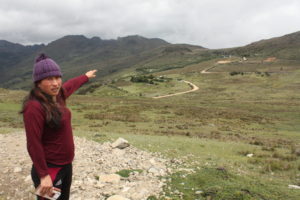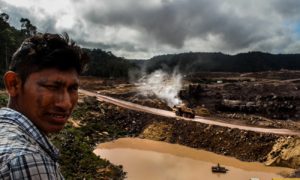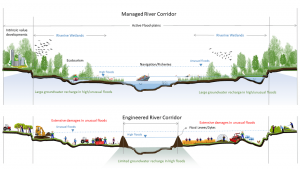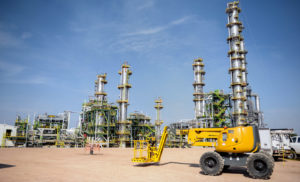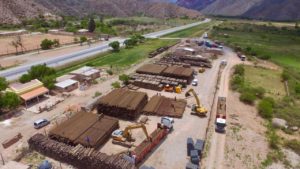Ever since more than 30 indigenous households were forcibly evicted by police and security personnel between September and December 2015, the River Quimi valley in the middle of the Ecuadorean Amazon has not had a moment’s peace.
Today, where these Shuar and Cañari-Kichwa families once lived, there gapes the gigantic open pit of the Mirador mine. The River Quimi descends from the Cordillera del Condor, a small mountain range in Zamora-Chinchipe province. The government hopes that copper extraction will begin there by the end of this year.
Mirador is the largest mine in Ecuador’s history and one of President Lenín Moreno’s “strategic” projects in a nationwide mining drive. Yet its future is uncertain in the face of a conflict between Chinese company Ecuacorriente and the villagers of Tundayme, who are intent on recovering what they consider ancestral lands.
The backdrop is a corner of the country that scientists and biologists consider a “lost world” of immense natural wealth.
Tundayme’s evicted
No one in the Condor can agree on whether Rosario Wari Ampush reached 95, 107 or, improbably, 120 years of age. However, all are certain she was the first in her family to die outside her home.
Two years before her death in July 2018, Wari Ampush and her son, who are indigenous Shuar, lost their ancestral home.
“They burned house. Grandparents built years ago. We were growing up and living there. They died there and left to us,” Rosario’s 64-year-old son Mariano Mashendo recounts in a broken Spanish almost devoid of articles. “You born here like trees, and age and die like them. Now, we don’t know what will happen with mining company. I am last of the family.”

Mashendo tells his story from a humble wooden hut, from where can be seen the blue roof of a mining camp occupying the spot where his home once was.
At least 32 families, some 126 people, lost their homes due to evictions which the community and NGOs described as violent. The process was similar each time. Officials arrived at dawn ordering them to hand over their land and saying a cheque for compensation awaited them at the office of mining regulator Arcom.
They were given five minutes to leave. Their houses were demolished, the rubble buried in front of them.
“We filed two suits for cattle raiding, as they took 120 head of cattle and we recovered only 48, but they haven’t acknowledged liability… There has been no response from the government,” says Luis Sánchez Shiminaycela, a prominent community leader who identifies as indigenous Cañari-Kichwa.
Sánchez’s wife, daughter, parents, two brothers, their wives and five children lived in two seized houses on the banks of the Tundayme River.
At the heart of the conflict is a legal designation known as “mining easement”, which enables the government to identify property as necessary for a development project. Instead of expropriating it, the government can mandate it’s rental for up to three decades. In return, landowners receive compensation.

“Even though people may say they don’t want to, or don’t understand the procedure, it doesn’t matter,” says attorney Francis Andrade of the Pan-Amazonian Ecclesial Network (Repam), a Catholic organisation.
Some victims were even Ecuacorriente employees at the time of eviction.
“They knocked my house down and caused me a great deal of pain, emotionally and psychologically. My parents lost their lives trying to leave us something and this company has left us with nothing,” says William Uyaguari, who worked for seven years loading drilling machinery for the mine. Uyaguari says he was fired after suing the company over the eviction.
Like others, Mashendo, Sánchez and Uyaguari rejected earlier purchase offers and, outraged by the eviction, decided not to claim compensation. Instead, they are challenging the mine in the province of Zamora Chinchipe as members of the Amazonian Community of the Cóndor Mirador Mountain Range (Cascomi), which unites indigenous Shuar, Kichwa and peasant families.
No houses remained on the eastern bank of the Quimi River, between the Tundayme and Wawayme tributaries, which flow down from the mountain and into the Quimi. Where the small hamlet of San Marcos once stood, with its church and school, there is a steep headland. Atop the cliff a gigantic hole will soon serve as a tailings pond.
On the horizon is a five-storey building hugging the edge of a hill. Behind it, Ecuacorriente S. A., also known as Ecsa, plans to open the pit to extract copper.
Tongling Nonferrous Metals Group, a mining conglomerate from China’s Anhui province and the country’s second largest copper producer, along with China Railway Construction Corporation (CRCC), one of the largest construction companies in the world, own the mine. Both are state-owned companies.
Tundayme’s story is not unique. Indigenous Shuar, who used to live where the Panantza-San Carlos copper mine now operates in another corner of the Cóndor mountain range 40 kilometres away, complained of similarly violent evictions. The owner of that mine is ExplorCobres S.A. (Exsa), which is also controlled by Tongling and CRCC.

From protests to courts
Powerless to stop the evictions, the indigenous people of Cascomi changed tactics. They took the company and the Ecuadorean state to court.
In Ecuador, as well as in other Latin American countries, local communities are now opting to complain via legal and political challenges, having realised that marches and roadblocks often lead to clashes with the police and criminal proceedings.
Many are winning. Last year, the courts decided that the Kichwa indigenous community of Río Blanco was not consulted on a gold mine in their territory. In October, another court ruled in favour of the Cofán of Sinangoe, who filed a similar complaint against mining concessions. Two months ago, the Waorani of the Amazon won a case against an oil project.
The residents of Tundayme have been less fortunate but continue to explore legal options in the ongoing Mirador conflict. Their case is complex, with at least five cases awaiting judgement.
The first and highest profile legal action argued that environmental rights had been violated.
In 2013, when Rafael Correa was president of Ecuador, four NGOs, a university, and the Shuar communities claimed the mine’s environmental impact assessment had not acknowledged the habitat of two endemic bird species where the mine pit would be.
Ecuador recognised the rights of nature in its 2008 constitution. Exterminating a species is tantamount to a violation of nature’s rights, the plaintiffs argued.

Dismissed by a judge in Quito, the case remains open in the Organisation of American State’s supranational Inter-American Commission on Human Rights.
At the end 2013, Correa shuttered one of the NGOs involved, the Pachamama Foundation. He accused it of interfering in state policy and threatening national security. In June 2012, the Inter-American Court ruled in favour of an action brought by Pachamama Foundation against the state over its failure to consult the indigenous Kichwa of Sarayaku an oil project.
A year later, high profile Mirador opponent José Isidro Tendetza was found brutally murdered with signs of torture on his body. As Mario Melo, Pachamama’s lawyer, said: “All this shows how sensitive the Mirador issue is.”
Confrontations with mining opponents, who Correa described as “stone throwers” and “backward townspeople” have eased under Moreno. Legal challenges to mines, however, have multiplied.
In February 2018, Cascomi filed a second action, accusing the state of violating their right to decent housing by sanctioning evictions. They demanded Ecsa compensate them.
This suit, supported by Repam and legal NGO Inredh, was based on three arguments.
First, they were never forewarned of the evictions. All they were told was that there would be a process of mining easements and, in some cases, hearings.
Secondly, evictions were arbitrary and violent. They occurred at antisocial times and destroyed property.
Finally, there was no relocation plan. Many families still live in overcrowded conditions in borrowed houses, or pay rent elsewhere with no means of supporting themselves.

The state countered that it does not consider Cascomi to represent an indigenous ancestral community and that Tundayme has no collective land deed demarcating the presence of an ethnic people who had to be consulted. (In Ecuador, like the US, indigenous communities own land under collective land deeds. The state says: no deed, not indigenous.)
The judge ordered an expert anthropological evaluation. But the report was inconclusive. It found that while Cascomi is not indigenous as an organisation, the territory is.
On 15 January 2019, a Quito judge sided with the government and dismissed the case, ruling that Cascomi is not indigenous and that evictions accorded with the law. After an appeal, on June 7 the provincial court of Pichincha upheld the ruling. Villagers are now preparing a final appeal to the constitutional court and will also submit to the UN Committee on Economic, Social and Cultural Rights.
There is also a criminal complaint against Ecuacorriente for environmental damage to water sources, presented by provincial indigenous governor Salvador Quishpe and the Confederation of Indigenous Nationalities of the Ecuadorean Amazon (Confeniae).
There is a request before the constitutional court, the country’s highest court, for risk management assessments that guarantee the dam Ecsa is building on the Tundayme River will not cause a disaster similar to Brumadinho in Brazil. This request is based on a study by US hydrologist Steve Emerman.
Finally, Cascomi and the communities of the nearby Panantza-San Carlos project, filed another action arguing that the state has failed to implement the Comptroller General’s recommendations on prior consultation and mining controls.
Cascomi leaders have spoken at hearings of the IACHR in Washington and at the UN’s periodic review of China’s human rights.
The lost world of the Cóndor
On crossing the Zamora River, mountains of an intense emerald colour suddenly rise up from the ground.
Two scientific expeditions to the El Quimi Biological Reserve, located 10 kilometres from the copper mine as the crow flies, revealed that the Cóndor mountain range is one of the most biodiverse locations in Ecuador.
Among the dwarf plants living on its rocky, flat table-top, scientists came across a minute but eye-catching brown frog with yellow spots. Following two years of study, they announced their discovery in January 2019. It was a treefrog, which they named Hyloscirtus hillisi, a new species. Its most peculiar trait is a large claw at the base of the thumb, a suspected defence mechanism.
They also found two other frogs, a lizard and a rodent in the enigmatic tepuis Amazon ecosystem that rises 2,000 metres above the jungle. These are being documented and are expected to be announced as new species imminently.
“It was such an extraordinary place, where no specimens had been collected before. We need to go back again, because there are so many species waiting to be discovered,” says evolutionary biologist and renowned herpetologist Santiago Ron.
Scientists at the Zoology Museum are still unsure what makes the Cóndor such a biodiverse place but they have several hypotheses. One is the limestone soil comprising millions of tiny seashells, something unusual in the Andes.
It’s comparable to the large rocky tepuis of the Guiana Shield that rise up sporadically in the Amazon, from Colombia to the Guianas of northeastern South America. Another is the strange mineral composition attributable to vegetable tannins that flow from their heights and give it a translucent cola-coloured hue.
As these unique habitats have a high proportion of endemic species, scientists recommended classifying the new treefrog as “critically endangered”, especially given the destruction of its habitat by the nearby Mirador mine.
Such high biological value prompted scientists to call for the designation of a national park in the Cóndor mountain range.
“We have so much to lose and we’re not taking proper care of resources that can benefit all of humanity,” says Santiago Ron.

There is another powerful, political reason why the area’s protection matters.
Between January and February 1995, a hundred people died during a brief war between Ecuador and Peru. The conflict centred on the Cenepa River on the Peruvian side of the Cóndor.
A peace treaty signed by the two countries in Brasilia in October 1998 put an end to more than a century of territorial disputes by promising to create contiguous national parks that would preserve the border area and mitigate future conflict. It even stipulated that indigenous people should be able to travel freely between them.
“We have made the decision, both countries, that where we used to fight, where Peruvian and Ecuadorean soldiers have died, we must honour their memories in the best way we can: by celebrating life. That is why, in that same place, we have created two ecological parks in perpetuity … so that never again can a drop of blood be shed in that part of our territories,” said then Ecuadorean President, Jamil Mahuad.
However, Ecuador has only created two small biological reserves (Quimi and Cóndor), which total 114 square kilometres.
“We feel betrayed because we helped the Ecuadorean government build these roads for the Army to use in the war, and now, when we need them, they abandon us,” says Luis Sánchez.
The scientists who have tried to publicise their findings remain concerned about the risk of open pit mine for Cóndor’s biodiversity.
“In Ecuador we don’t take into consideration the environmental mishaps of mining,” says Ron.

Ecuadorean and Chinese national interests
Faced with dipping global oil prices, Ecuador’s last two governments sought alternative revenue streams and focused on mining.
With 3.18 million tonnes of copper, 3.39 million ounces of gold and 27.11 million tonnes of silver, Mirador is the jewel in the crown of the country’s plans for mining to contribute 4% of GDP by 2021.
Despite this, neither the government nor Ecuacorriente recognise the legacy of social and legal conflict that persists in Mirador and that could hinder its future operation.
The current government blames past mistakes on Correa’s belligerence. “We want to do things differently,” says Benalcázar, vice-minister for mining at the Ministry of Energy and Non-renewable Resources. “We want to have adequate financial, legal and security conditions in place for investors to come, with an understanding of the existing laws and regulations.”
Benálcazar cites Moreno’s 2018 decision to create a super-ministry to promote a long-term policy on hydrocarbons, mining and energy.
For the vice minister, the mine’s advantages are obvious: 3,000 direct and 10,000 indirect jobs; US$211 million in anticipated royalties and taxes; US$5.5 billion total income for the government, with 60% of the royalties to be invested at the local and provincial levels, according to the law.
Partnering with a Chinese company also gives them guaranteed access to the world’s largest copper market.

“I have not witnessed any conflict. What I have seen leads me to think that a good relationship exists. They have very interesting community projects involving environmental and social issues,” says Benalcázar, who used to work in the oil sector in Colombia and Syria.
The ministry, he says, is working with Ecsa to demanding action plans to resolve environmental violations and improve industrial safety after two fatal accidents at the mine in late 2018. It also aims to increase employment of local, rather than Chinese, workers.
Ecuacorriente says it has already invested US$1.4 million in Mirador and acknowledges that relations with the communities were initially tense. It insists that they have improved since channels for dialogue were opened and community projects including folkloric dance workshops invested in.
The company is adamant that the court ruling which declared the lands of public interest justified the evictions.
“If the two parties fail to reach an agreement and the price is unreasonable, the government may resort to the right of easement as a national strategic project. It was not our company that carried it out, but the Ecuadorean government,” says Jun Zhu, Ecsa’s head of community relations.
“They proposed the solution when the project was at a standstill,” Jun says. The company, he explained, paid up to six times the market price for the land and is building the new town of Nuevo San Marcos to relocate affected families.
Neither of the two recognises Cascomi as a valid complainant, insisting that the courts proved it is not an indigenous organisation and does not have collective rights. They also say it has been manipulated by foreign actors.
“South Americans are very decent people, but are easily mobilised by slogans, especially of the spiritual or anti-materialist sort,” says Jun. “Although they are poor in life, they don’t understand that these resources can satisfy their needs, and many NGOs seize on this to promote illusions, such as opposing mining or protecting the environment for future generations. And it is easy to believe their words.”
Like Río Blanco, the Mirador case highlights that indigenous self-identification is complicated. “To be honest, I don’t think it is their own initiative. They are influenced by the NGOs, for better or for worse… It is difficult to deal with NGOs that have extreme positions and are against any kind of development”, says Benalcázar, despite the Ecuadorean government itself promoting self-identification since 2010.
Many social and academic organisations disagree.
“It is often believed that communities do not have self-determination, that their strategies and discourse are those of others who manipulate them, as if they were children or fools,” says Ivonne Yáñez, a biologist with the NGO Acción Ecológica.
“The state believes it is a question of employment, royalties and direct foreign investment, and not the environment”, Yáñez adds.
“That [self-identification] doesn’t mean there isn’t a right, which must be respected and protected, to be consulted and to protect their homes”, agrees Mario Melo, director of the Catholic University’s Human Rights Centre.

The Inter-American Court’s ruling on Sarayaku in 2012 ordered that prior consultation be regulated in Ecuador in accordance with international norms. This motivated an official visit by Victoria Tauli-Corpuz, the UN’s special rapporteur on indigenous peoples, last November. Mirador was one of six places she visited.
Benalcázar confirmed that the government is working on a draft regulation.
Several parties seem unaware of the complexities of a territory where diverse groups have co-existed since the mid-20th century.
The Shuar, who were originally nomads, are the most numerous people of the Ecuadorean Amazon. The first settlers were the Ampush family, in 1910. Four decades later, thousands of Kichwa families migrated from the highlands to the jungle in search of land to cultivate. Among them were Luis’ family from the Sigsig mountains.
Many arrived thanks to agrarian incentives from the military dictatorship that took power in 1963, which sought to guard the border with Peru. However, that policy meant indigenous peoples from the highlands occupying other ethnic groups’ ancestral territories.
The state did not recognise collective land deeds of Amazonian peoples such as the Shuar of Tundayme, paving the way for future conflicts such as that of Mirador.
With an absent state and no space for dialogue, disputes in remote territories can rapidly escalate into open conflicts. When the government becomes aware and reacts, it is often too late.
“Instead of militarising and evicting people, sending machinery and backhoes to bury houses, the state should intervene differently, helping communities to plan,” says Jaime Vargas, Achuar leader and president of the Confederation of Indigenous Nationalities of Ecuador (Conaje).
The environmental issue, meanwhile, seems relegated to second place.

“If the region is so [biologically] rich, if it meets the requirements to be part of the system of protected areas – which is an exhaustive process – and becomes one, we will respect it,” says Benálcazar. “That was the decision of the Ecuadorean people,” he adds, referring to the February 2018 referendum that banned mining in protected areas.
Benálcazar had not heard of the newly discovered frog, nor of the state’s commitment to create a national park in the Cóndor. He did say he wants to work on biodiversity and water management with large international NGOs like the World Wildlife Fund, the Wildlife Conservation Society and The Nature Conservancy.
Ecuacorriente, for its part, insists that Tongling has never had any accidents and that its mine has the highest technical standards.
“The fact that one dam in Brazil collapsed does not mean all the dams in the world will be affected. It must be because they didn’t do their job well,” says Zhu. He says he still hopes for reconciliation with Cascomi and the Tundayme population.
Despite the appearance of tranquillity that the company and the government seek to present, a significant portion of the local population still feel their concerns have been ignored. The number of lawsuits shows that if efforts are not made to diffuse the conflict. Operations at Mirador will begin extracting copper without the community’s consent.
As Melo says: “People have seen that legal actions can be an alternative. That’s good, because if the violence escalates, everyone loses.”

This report, the second in a three-part series jointly reported with Lulu Ning Hui on the environmental and social footprint of two Chinese mining projects in Ecuador, received support from the Rainforest Journalism Fund through the Pulitzer Center on Crisis Reporting.


